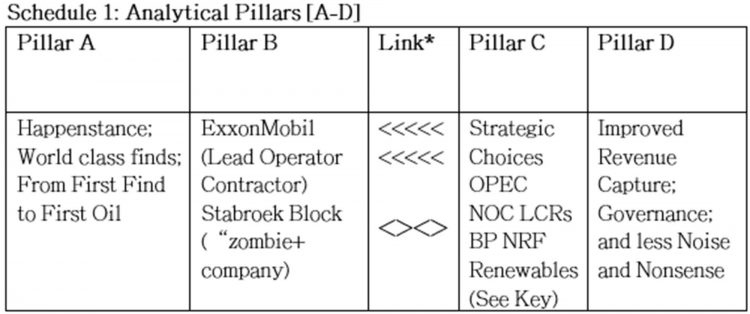Introduction
Today’s column starts with a brief acknowledgement of my completion of the indicated “considered critique” of ExxonMobil’s performance in relation to global climate change and energy transition. This began on April 10, 2022. It has centred on four major areas of the company’s actions over the past decade and a half. These are: 1) its record of environmental damage caused by oil spills; 2) longstanding allegations against the company that are still being adjudicated in the Courts, in regard to the firm’s alleged deceitful behavior; 3) allegations of the firm’s subterfuge and practiced disinformation in relation to its practice in climate change and global warming denial; and 4) empirical studies that reveal significant gaps between carbon reduction pledges made by ExxonMobil and its actionable outcomes.
Having concluded this, and also taking into account that three months of Sunday columns have appeared since I introduced this new topic area on January 16, 2022, into my ongoing series on Guyana’s emerging oil and gas sector, at this point I seek to introduce a summary recap of where this analysis presently stands in relation to the original intent of the series.
Recap
After 13 consecutive Sunday columns elaborating the Buxton Proposal for a universal basic income for Guyanese households [to January 9 2022]; starting on January 16 this year, I had put forward another proposal going forward. That is, to undertake, in coming columns, to provide a general theory, formularisation, or thesis that offers a sufficient explanation or reasoned construct, which correctly expresses the ruling or governing dynamic that most fittingly captures the clearly unprecedented historical emergence of Guyana’s world-class petroleum finds/discoveries; starting with ExxonMobil’s announcement in May 2015 and projected to last, comfortably, up to the end of Guyana’s first decade of oil and gas sector production [2025/26]. Despite start-up setbacks, there has been a steadily emerging consensus, backed by finds that on its present trajectory, Guyana’s daily rate of crude oil production, DROP, will reach around one million barrels of oil equivalent per day; that is, 1mlnboe/d
This self-imposed task is to be accomplished in four components, which will be briefly recalled in this section. The four components constitute the analytical pillars on which the thesis I am advancing rests [A-D].
As earlier indicated, these pillars of analysis are:
A) Formulating a “general explanation for Guyana’s creaming curve.” This reveals an unprecedented growth in Guyana’s petroleum discoveries for the period from the First Discovery [mid- 2015] to Guyana’s First Oil [December 2019].
B) Articulating the “essence/ nature of ExxonMobil”. This is the lead firm, lead contractor, and lead operator. It is expected to be located mainly, but not exclusively, in the Stabroek Block; for the entirety of the period of this analysis. That is, for the first full decade of Guyana’s oil and gas sector [mid-2015] to [2025/26].
Pillars C and D focus principally on those actions I have been recommending the Authorities to take in this ongoing Sunday series of columns. Thus C) refers to recommendations, which I have made repeatedly in regard to the Natural Resource Fund, NRF; my proposal to establish a National Oil Company, NOC; advice on whether to join OPEC or not; local content requirements, LCRs; and finally, the Buxton Proposal, which I have revisited over the past 13 weeks.
Similarly, item D] refers to improved revenue capture, governance, and public openness, in the face of relentless noise and nonsense in the local social and print media. Previously I had used the following Schedule 1 with one significant addition to illustrate an analytical schema of the self-imposed task and its four pillars as described above. I repeat it here for readers’ convenience. In the next section, I shall indicate where the analysis stands as of today and my intention going forward [the addition to the Schedule is noted there.]
Key: NOC= National Oil Company; OPEC= Oil Producing Exporting Economies; LCRs= Local Content Requirements; BP= Buxton Proposal; NRF= National Resource Fund; *= linking [A+B] & [C+D] analysis.
Going Forward
As matters stand this week, I have completed both Pillars A and B as displayed in Schedule 1. In Pillar A, I have advanced the thesis that “happenstance” is the most apt characterisation of Guyana’s historic creaming curve of world-class oil and gas discoveries. That is, aggregated oil reserves found plotted against the number of wells drilled. Pillar B was completed last week when I concluded my critique of ExxonMobil, which has labelled ExxonMobil a zombie plus company. Readers can find the articles in Sunday Stabroek newspapers from January 18, 2022 to April 24, 2022.
Pillars A and B broadly cover the theoretical areas of the task I have been pursuing in these columns and have summarily restated above. Similarly, Pillars C and D focus mainly on policy choices and their implementation. The column labelled “link” indicates a bridge between the two areas of analysis.
Conclusion
Next week, I shall introduce details on the bridging link between the theoretical formulation and policy concerns. My argument is that the bridging link is in essence the revealed state of play or current condition of Guyana’s emerging oil and gas sector. This is broadly captured in a number of specifics, markers, and data points I have laid down thus far. To illustrate, over the next two weeks I shall advert to several of these.







